A Step by Step Guide to Checking if a SaaS is Down
Introduction
Last updated on August 8, 2025.
Modern businesses depend heavily on Software as a Service (SaaS). SaaS is not limited to being used by software development teams. Almost all aspects of business operations - accounting, HR, payroll, marketing, IT, sales, support - depend on one or more SaaS applications. Given this dependency on SaaS applications, their uptime becomes tightly tied to a business's uptime. Any SaaS downtime can affect both a business's daily operations as well as the user experience. Measuring the uptime of SaaS providers is a critical part of your incident management process and business continuity plan.
How to check if a SaaS is experiencing downtime? Follow the steps below:
- Introduction
- Visit the SaaS Provider's Status Page
- Use Status Page Monitoring Services
- Check Social Media for SaaS Downtime Information
- Run Manual Tests Against Your SaaS
- Incident Communication
- Conclusion
- Summary Table
- FAQ
- Popular SaaS Service Statuses
Visit the SaaS Provider's Status Page
The SaaS provider's status page will have first-hand information about ongoing issues. Services use their public status page to communicate with their users and customers. Any ongoing outages or maintenance will be listed on the status page.
Locate the SaaS provider's Status Page
You can find this by either doing a web search like "Zoom status page" or "OpenAI status page". You can also visit the SaaS provider's website and look for the status page link - it is usually in the footer. Another option is to check their documentation or support portal. If it's not available ask on their social media handles.
Understanding Status Pages
A SaaS provider's status page will indicate if the service is experiencing any downtime. Common status indicators are
- Degraded performance
- Service disruption
- Partial outage
- Maintenance
Status pages differ from service to service but they usually have this structure:
- Current status of the service and individual components or regions. If there are any ongoing downtime issues they will be linked to pages with detailed information about the downtime.
- Ongoing or upcoming maintenance.
- Historical availability data.
- Optionally, a visual representation of the service's status - sometimes shown as a series of bars, or even as a global map.
For an example, take a look at the OpenAI status page.
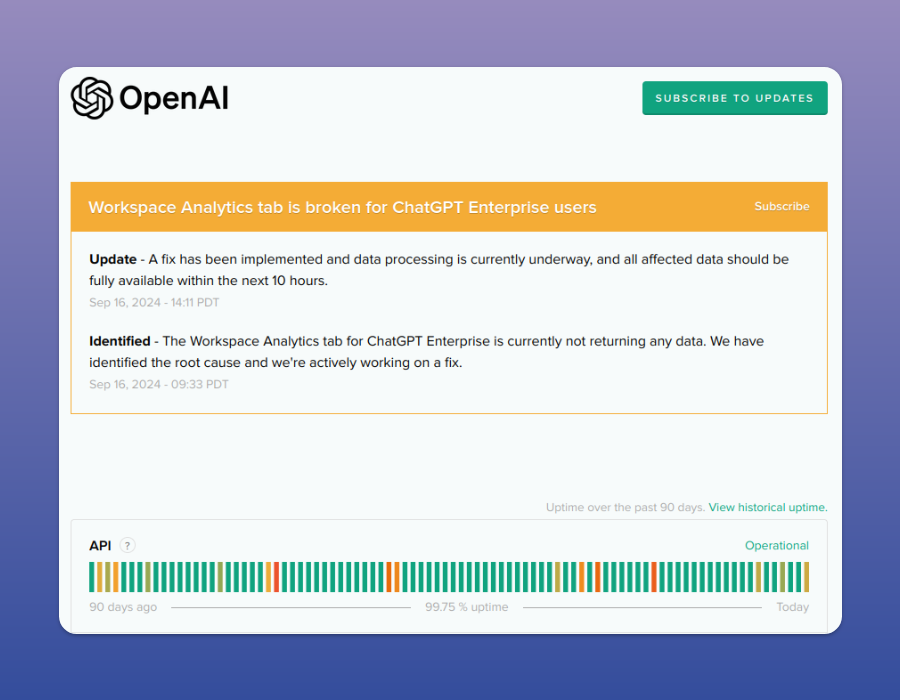
Status pages also show you past incidents:
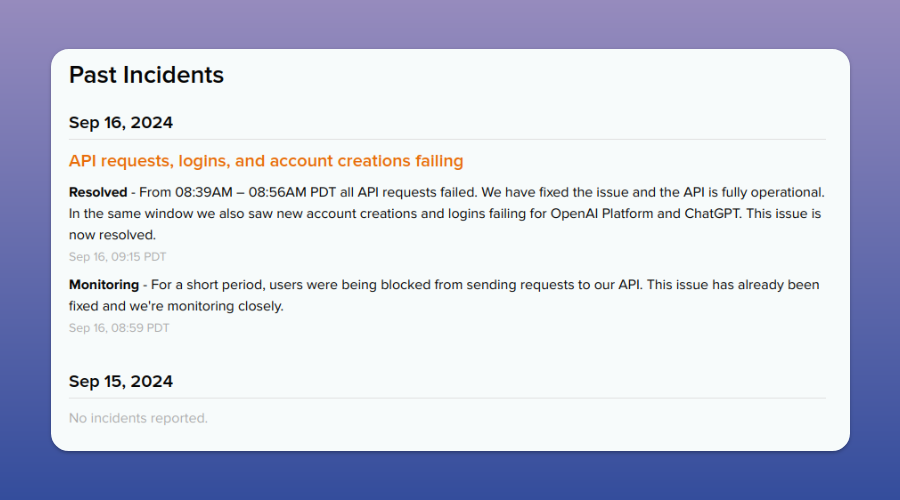
You can find more information about the outage by clicking on the incident link on the status page. It will have details about which components, services, or datacenters are affected by the outage. If your SaaS has many independent locations or datacenters, like a cloud provider, look for region/zone information as well. It's possible that the outage is limited to some components or locations. Check if any of the components or services you use are in the list. If it's a cloud provider or a similar service, check if the affected locations are among the ones that you use.
E.g. this Google Cloud outage affected Google Compute Engine in the asia-northeast1 region.
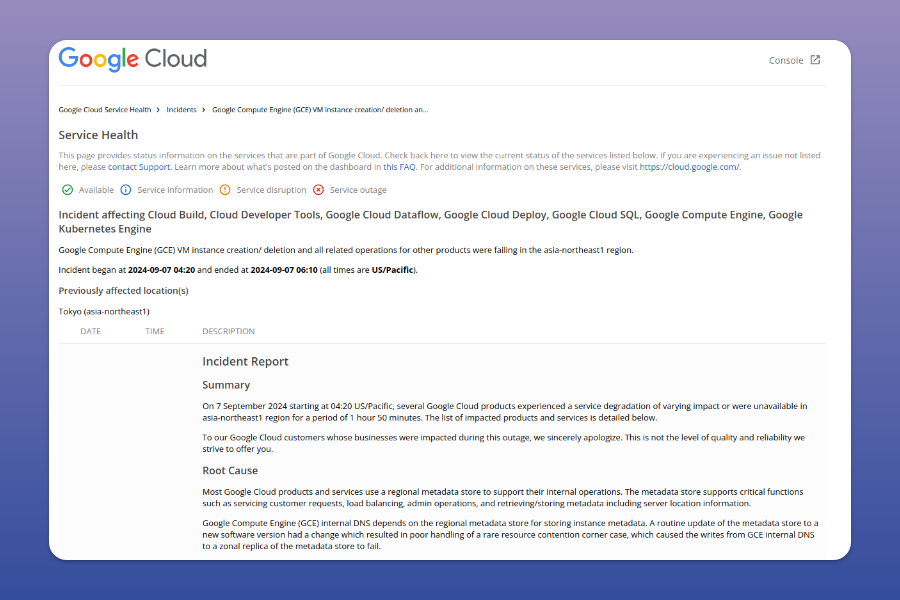
Use Status Page Monitoring Services
There are many status page monitoring tools that can track SaaS uptime. They are designed to continuously check the availability of SaaS services. These tools take away the hassle of you having to check uptime manually especially if you have many SaaS applications. Checking the status page of each SaaS application can become cumbersome. A status page aggregator tool like IncidentHub can make this easy by showing you the overall status of all your SaaS providers in one place.
Setting Up a Status Page Monitoring Tool
IncidentHub is a monitoring tool that checks official status pages of hundreds of SaaS applications. It notifies you in real-time if there is an outage or downtime. Setting up IncidentHub is just a few steps
- Create a free account at https://incidenthub.cloud/sign-up
- Choose the services you want to monitor
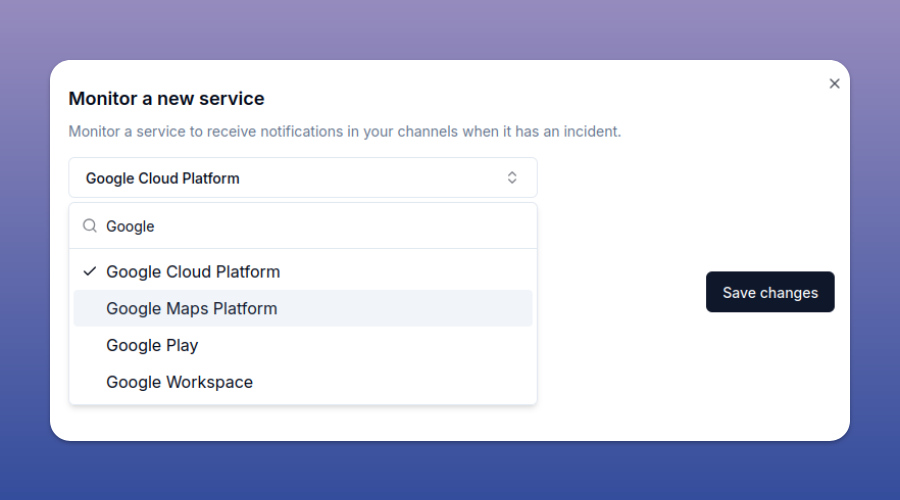
- Choose how you want to get notified
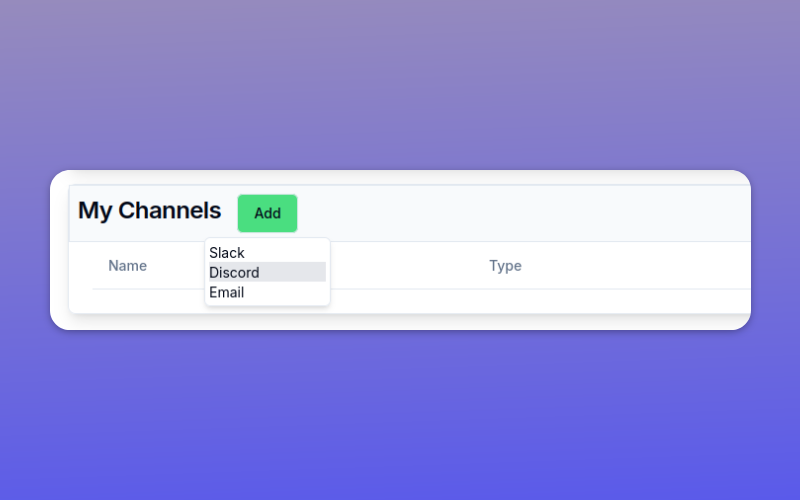
- Alternatively, you can use the free unified public status page that IncidentHub provides.
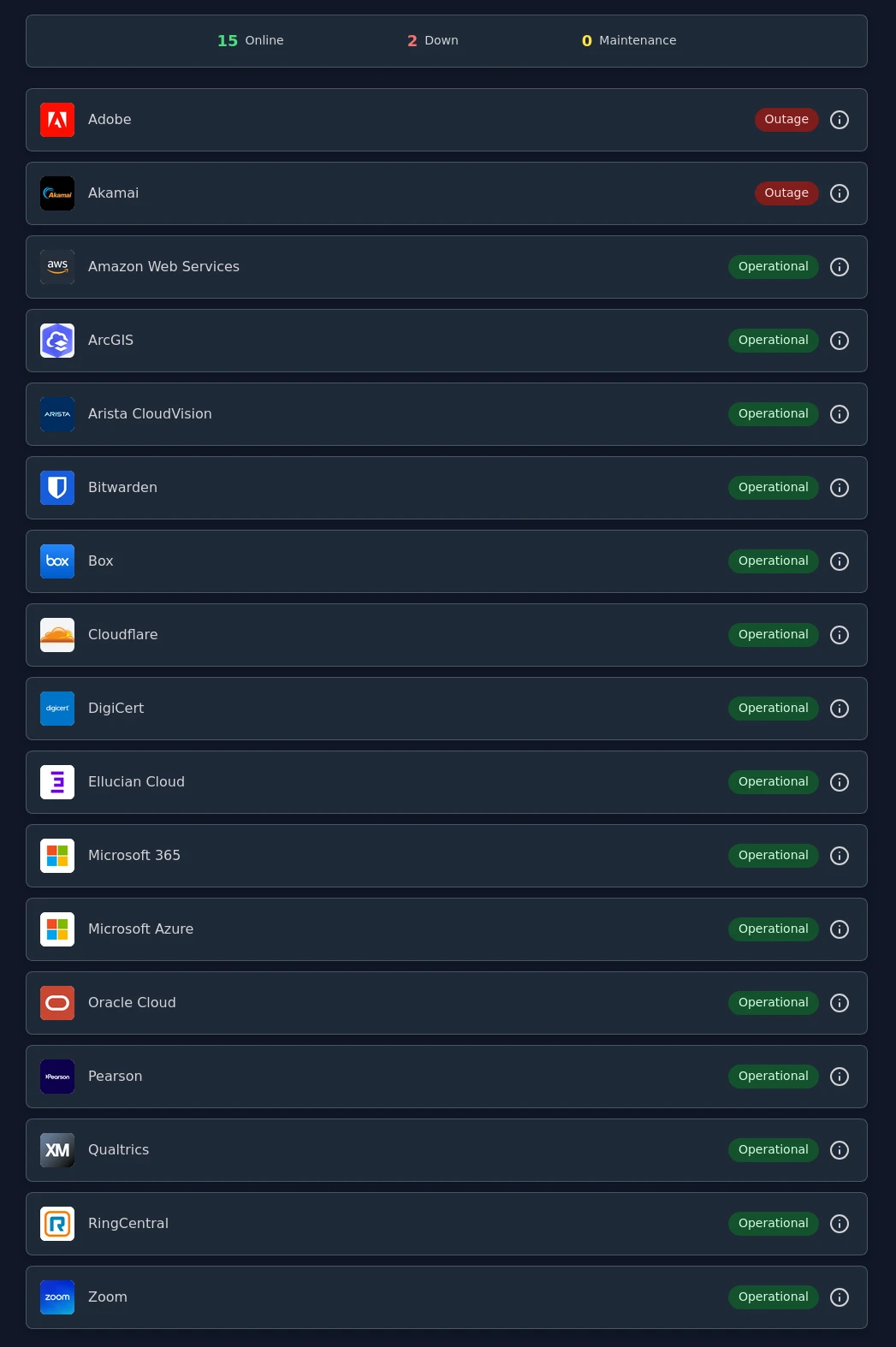
Check Social Media for SaaS Downtime Information
Twitter and Reddit are popular platforms to find SaaS downtime information. Users post on these platforms to find more information and to check if others are also experiencing similar downtimes with the service. Such platforms can often provide real-time updates from other users. A caveat here is that if the outage is localized to some components or regions, you may not always find information about it on social media.
If your SaaS has a sub-reddit, check the latest postings there for information. For example, the Discord sub-reddit often has users posting about Discord outages.
Other community forums where users of the SaaS hang out can also provide important outage information.
Run Manual Tests Against Your SaaS
Running manual tests is another way to check if your SaaS is experiencing downtime. Check common functionality issues such as login failures, API errors, resource creation issues, and other specific functionalities. Correlate these with the official status page data, and what other users are reporting on social media. This is more of an ad-hoc method but it can add valuable information.
Incident Communication
It's very important to communicate with your team and your stakeholders about ongoing SaaS incidents. Your users and other business stakeholders should be notified as soon as you know there is an outage. This helps them to plan their work accordingly, and also decreases the number of user requests and helpdesk tickets you might get.
Incident communication is effective when you continuously share updates as they occur. It builds trust with your users. It's even better if users can check the status of their SaaS applications themselves on a status page or a dashboard.
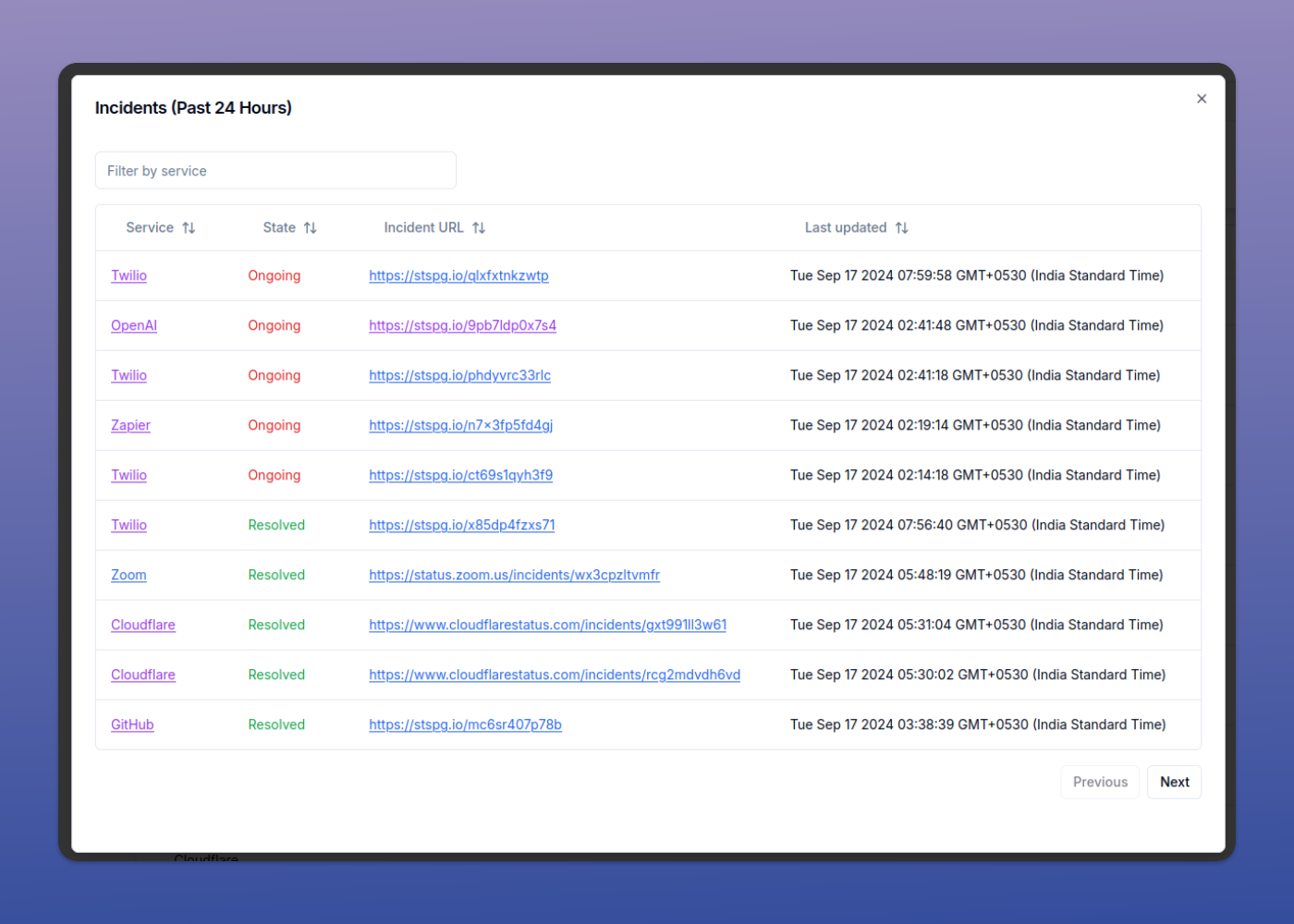
An example of an incident dashboard in IncidentHub
Create alerts in your monitoring tool to inform your team about the status of services. Monitoring tools can integrate with most communication tools like email, Slack, Discord, etc.
Conclusion
In summary, you can check if your SaaS applications are down by checking the official status pages, using a monitoring tool, checking social media, and running manual tests. Keep communicating with your users about the current status.
This guide offers a clear method for users to quickly determine if their SaaS applications are down.
Summary Table
Here's a tabular summary of the methods to check if a SaaS is down:
| Method | Key Steps | Benefits |
|---|---|---|
| Visit the SaaS Provider's Status Page | • Search for status page via web search or company website • Check for ongoing incidents, maintenance, and historical data • Review specific component/region information | • First-hand, official information • Detailed incident information • Historical availability data |
| Use Status Page Monitoring Services | • Set up monitoring tool (e.g., IncidentHub) • Choose services to monitor • Configure notification channels • Use unified status page dashboard | • Automated monitoring • Real-time notifications • Single view of multiple services • Reduces manual effort |
| Check Social Media | • Monitor Twitter/X for real-time updates • Check SaaS-specific subreddits • Review community forums | • Real-time user reports • Community-driven information • Quick validation of issues |
| Run Manual Tests | • Test login functionality • Check API responses • Verify specific features • Correlate with other sources | • Direct verification • Specific functionality testing • Immediate feedback |
| Incident Communication | • Notify team and stakeholders immediately • Provide continuous updates • Use monitoring tool integrations • Share status dashboard with users | • Builds trust with users • Reduces support tickets • Improves incident response |
FAQ
How can you locate a SaaS provider's status page?
Check the SaaS provider's website, or run a web search.
Why is an external monitoring service important to track SaaS outages?
External monitoring tools continuously check SaaS status pages and other sources for incidents. They also check multiple SaaS providers at the same time. Doing this yourself is impractical and time-consuming.
How can you use social media to find out about SaaS downtime?
Popular social media channels like Twitter and Reddit often have real-time updates about SaaS outages from users who are experiencing downtime. SaaS-specific subreddits can be a good source of such information.
Popular SaaS Service Statuses
Airtable status
Akamai status
Azure status
Cloudflare status
Coinbase status
Discord status
Dropbox status
Fortnite status
GitHub status
Google Cloud status
Hetzner status
npm status
OpenAI status
PayPal status
Railway status
Reddit status
Rollbar status
SendGrid status
Twilio status
Vercel status
Zapier status

